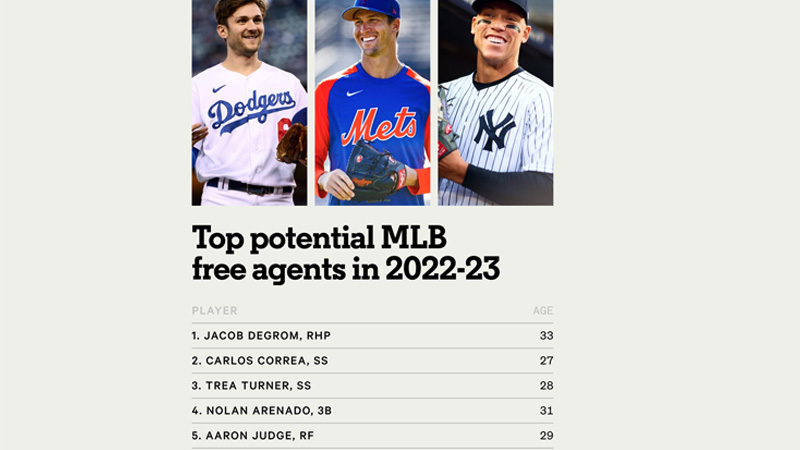In the world of baseball, free agency serves as a pivotal mechanism that grants players the freedom to explore the open market and negotiate contracts with any team in the league.
This article delves into the significance of free agency in player contracts, exploring its historical background, service time requirements, and the implications it holds for both players and teams.
Definition
In the realm of professional sports, the term “free agency” embodies a powerful notion—allowing players the freedom to choose the team they desire.
This unrestricted approach enables athletes to engage in negotiations with multiple interested teams, ultimately signing contracts that align with their market value.
Free agency stands as a testament to the dynamic nature of the sports industry, where players have the autonomy to shape their careers.
The Threshold of Six Years of Service Time
Reaching the six-year mark of Major League service time is a defining moment for players in their quest for free agency.
Once this milestone is achieved, players are eligible to become free agents, allowing them to chart their own courses and seek opportunities with any club they desire.
It signifies a significant transition in a player’s career, as they gain the autonomy to negotiate contracts on their terms.
Release from an Organization and Pre-Free Agency

Source: @TheAthletic
In certain circumstances, a player may be released from their organization before completing six years of service time. Despite not meeting the service time requirement, these players still attain free agency status.
The release serves as an alternative pathway to freedom, allowing players to explore opportunities with other teams. It presents them with a fresh start and an opportunity to showcase their skills in new surroundings.
The Power of Free Agency
Free agency is a transformative period for players in MLB. It provides them with the freedom to negotiate with any club, unbound by previous contractual obligations.
The player and the new club have the flexibility to craft an agreement that aligns with their mutual interests. This newfound freedom allows players to seek the most favorable terms, both financially and in terms of team fit, enabling them to make career-defining decisions.
Contractual Obligations for Players with Fewer Than Six Years of Service Time
It is important to note that if a player with fewer than six years of service time signs with a club, they remain under the control of that particular organization until they accumulate the necessary service time to reach free agency.
Even if the contract signed does not cover the remaining years until that point, the player is bound to fulfill the contractual obligations until they become eligible for free agency.
This provision ensures that clubs maintain a certain level of control over developing players and protects their long-term interests.
The Pursuit of Options and Market Value
Within the framework of free agency, players have the opportunity to assess their worth on the open market.
By engaging in conversations with various teams, they gain valuable insights into their market value and potential opportunities for growth.
This process empowers athletes to make informed decisions about their professional futures, ensuring they align with the teams that best complement their skill sets and ambitions.
The Return to Familiar Grounds
While players may explore alternative options during the free agency period, it is not uncommon for them to return to the team they represented in the previous season.
The allure of familiarity and the established camaraderie within a club often entices players to reconsider their initial departure. Unless a player receives a qualifying offer, their former team is not entitled to any form of compensation if they opt to pursue opportunities elsewhere.
This aspect of free agency underscores the fluidity of player movement and highlights the importance of mutual respect between athletes and their respective organizations.
Historical Background
The implementation of the reserve clause in 1879 marked a turning point in baseball’s labor relations.
This clause bound players to their current teams even after their contracts expired, severely limiting their bargaining power and salary potential. Consequently, players were subjected to one-year contracts with little leverage for higher salaries.
Furthermore, baseball’s exemption from antitrust laws, as established by a Supreme Court ruling in 1922, further solidified the control of team owners over players’ rights.
This exemption, viewing baseball as entertainment rather than a business, prolonged the era of restrictive labor practices.
Curt Flood’s challenge to the reserve clause in 1969 brought the inequities of the system into sharp focus.
Flood, who refused a trade, aimed to assert his right to offer his services to any team. Although he ultimately lost the legal battle, his courageous stand set the stage for future breakthroughs.
The Era of Free Agency
In 1975, pitchers Andy Messersmith and Dave McNally challenged the reserve clause in a landmark case.
With the support of Marvin Miller and the Players Association, they argued that the reserve clause did not explicitly stipulate perpetual contract renewal.
Arbitrator Peter Sites ruled in their favor, declaring them free agents and paving the way for others to follow suit.
MLB owners initially challenged the ruling but ultimately reached an agreement with the players.
This agreement established the criteria for free agency eligibility, granting players with six or more years of major-league service the right to explore the open market and sign with any team.
Service Time and Eligibility
Service time refers to the number of days a player spends on the 26-man roster or the major league injured list. Each day spent on the roster or injured list contributes to the accumulation of service days.
A player needs a minimum of six years of major-league service to become eligible for free agency. Exceptions are made for players serving suspensions for violations such as drug use or domestic violence. Players in suspension do not accrue service time during their suspensions, affecting their eligibility timeline.
Contract Implications
During the pre-arbitration years, typically the first three seasons, players’ salaries are often close to the league minimum. Limited bargaining power during this phase can result in players earning less than their performance merits.
Salary arbitration provides a platform for players with three to six years of service to negotiate their salaries for the upcoming season. If no agreement is reached between the player and the team, an arbitrator steps in to determine the appropriate salary.
Teams often sign star players to multi-year contracts during the arbitration years to secure their services for an extended period. This strategy helps teams retain key players and provides financial security for the athletes.
The Super Two designation grants players with at least two years and a specific number of service days an extra year of arbitration. This provision compensates players who make their debuts later in the season, preventing them from being stuck at the league minimum for an additional year.
Non-tender free agency occurs when players with less than six years of service are not offered contracts by their teams. This can be a strategic roster management decision or an opportunity for players to find new opportunities elsewhere.
How Much Do MLB Free Agents Get Paid?
The compensation received by players hinges upon a multitude of factors: their duration of service, contributions to the sport, and the financial commitment a team is willing to undertake.
Presently, the average annual salary stands at $18.4 million, experiencing a slight decrease of $500,000 compared to the previous year’s figure of 2020.
However, it is worth noting that a significant number of players ink contracts that offer considerably lower remuneration. In the 2021-22 offseason, the veteran minimum salary was established at $570,000 per annum.
To provide a stark contrast and a broader perspective, let us consider the case of Mike Trout, who earned an astounding $37.1 million in 2021, despite being absent for the majority of the season.
How Long Does MLB Free Agency Take?
Major League Baseball distinguishes itself from many other leagues with its long duration of free agency.
The process commences precisely at 9:00 am ET on November 3, 2021, granting all players whose contracts have expired the status of unrestricted free agents.
They are immediately permitted to engage in discussions with potential teams, albeit they must endure a minimum waiting period of five days before finalizing agreements with new clubs.
Concurrently, teams are confronted with the task of making determinations concerning contract options for players entering the pivotal “team-option” years.
Throughout the offseason, and even extending into the early stages of the subsequent season, free agents retain the liberty to forge alliances with teams.
It is noteworthy that the majority of significant transactions occur within the initial weeks or months of free agency, while last-minute signings predominantly cater to circumstances involving injuries or seasoned players.
Conclusion
Free agency has transformed the landscape of professional baseball, empowering players to have control over their careers and negotiate contracts that reflect their value.
Understanding the historical context, service time requirements, and the implications it holds for player contracts is crucial in comprehending the dynamics of free agency.
Players with six or more years of major-league service become the major free agents commanding significant attention and lucrative deals.
However, it is important to note that there are exceptions and complexities within the system, such as the Super Two designation and non-tender-free agency.
By clarifying the rules and eligibility requirements of free agency, this article aims to debunk misconceptions and provide a comprehensive understanding of the significance of free agency in the realm of baseball.
It highlights the importance of players with six or more years of service as the focal point of major free agency discussions.
Free agency has not only transformed player contracts but has also empowered athletes to have more control over their careers, ushering in a new era of fairness and competitiveness in professional baseball.







